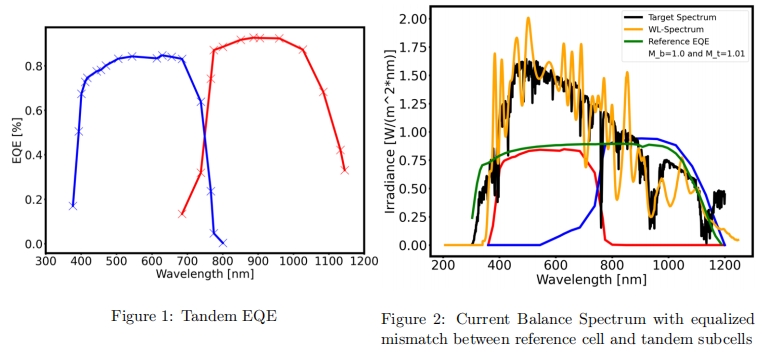| Fast and accurate analysis of perovskite-silicon tandem cells with LED based solar simulators【Sascha Esefelder】 |
| 发布时间:2024-10-31 | 浏览次数:51 |
Fast and accurate analysis of perovskite-silicon tandem cells with LED based solar simulators Lukas Ziegler, Bernhard Kl¨oter, Stephan Bergemann, Sascha Esefelder Wavelabs Solar Metrology Systems GmbH,Germany E-mail: s.esefelder@wavelabs.de Abstract Performance analysis of tandem cells is much more subtle than for single junction cells. On the one hand, a proper calibration requires the adjustment of the spectrum based on the EQEs of the subcells. On the other hand, the perovskite’s dynamics originating in ion movement and other new phenomena prevent scanning the cells with a fast IV measurement. As NREL found out, only 16% of the scientific reports adjusted their spectrum properly and only 25% performed a stabilized IV measurement leading to incorrect and incomparable results in the tandem community 1 . Fortunately, with the rise of LED flashers, we are able to accurately execute a performance analysis in several minutes including Tandem EQE, Spectral Adjustment and Stabilized IV. The idea of an accurate calibration is that the tandems’ subcells must produce the currents as they would under AM1.5G reference spectrum. The simulator intensity is usually set up based on a single or multiple reference cells which can in principle differ from the device under test. The calibration process can be expressedin a formula as follows.
Where i is the subcell index and j is the reference cell index. I are the short circuit currents, Mi,j are the mismatch factors and IDUT ,AM15G,i = IDUT ,Sim,i is the condition for perfect calibration. As for intensity calibration, there are two options: First, two specially filtered reference cells can be chosen and the LED spectrum can be adjusted for each subcell until the mismatch corrected currents of the subcells match the reference values. The second option is to generate a current balanced spectrum which ensures equal mismatch between the two subcells and the single reference cell. This procedure is especially elegant because we are able to generate spectral accuracy in several seconds by adjusting LED channels even working for multi-junction cells with more than two subcells. In either case, the EQE measurement is required to perform a mismatch correction. In comparison to conventional EQE measurement devices, LED based EQE measurements have several advantages. First, the EQE routine is scalable in size and can be performed on small cells up to big modules. Secondly, the bias illumination comes from the same light engine as the probing light, both exhibiting high uniformity. Most important, a full Tandem-EQE measurement can be performed in 500 ms making it accessible for production lines and allowing fast and accurate material analysis.
|








